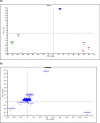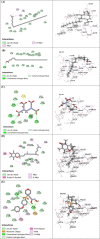Chemical and biological characterization of Melaleuca subulata (Cheel) Craven leaves' volatile constituents supported by chemometric analysis and molecular docking
- PMID: 38317130
- PMCID: PMC10840179
- DOI: 10.1186/s12906-024-04345-0
Chemical and biological characterization of Melaleuca subulata (Cheel) Craven leaves' volatile constituents supported by chemometric analysis and molecular docking
Abstract
Background: The genus Melaleuca (Myrtaceae) comprises dozens of essential oil (EO)-rich species that are appreciated worldwide for their various medicinal values. Additionally, they are renowned in traditional medicine for their antimicrobial, antifungal, and other skin-related activities. The current study investigated the chemical profile and skin-related activities of volatile constituents derived from M. subulata (Cheel) Craven (Synonym Callistemon subulatus) leaves cultivated in Egypt for the first time.
Methods: The volatile components were extracted using hydrodistillation (HD), headspace (HS), and supercritical fluid (SF). GC/MS and Kovat's retention indices were implemented to identify the volatile compounds, while the variations among the components were assessed using Principal Component Analysis and Hierarchical Cluster Analysis. The radical scavenging activity was assessed using 2,2-diphenyl-1-picrylhydrazyl (DPPH), oxygen radical absorbance capacity (ORAC) and β-carotene assays. Moreover, the anti-aging effect was evaluated using anti-elastase, and anti-collagenase, while the antimicrobial potential was deduced from the agar diffusion and broth microdilution assays. Lastly, the molecular docking study was executed using C-docker protocol in Discovery Studio 4.5 to rationalize the binding affinity with targeted enzymes.
Results: The SF extraction approach offered the highest EO yield, being 0.75%. According to the GC/MS analysis, monoterpene hydrocarbons were the most abundant volatile class in the HD oil sample (54.95%), with α-pinene being the most copious component (35.17%). On the contrary, the HS and SF volatile constituents were pioneered with oxygenated monoterpenes (72.01 and 36.41%) with eucalyptol and isopulegone being the most recognized components, representing 67.75 and 23.46%, respectively. The chemometric analysis showed segregate clustering of the three extraction methods with α-pinene, eucalyptol, and isopulegone serving as the main discriminating phytomarkers. Concerning the bioactivity context, both SF and HD-EOs exhibited antioxidant effects in terms of ORAC and β-carotene bleaching. The HD-EO displayed potent anti-tyrosinase activity, whereas the SF-EO exhibited significant anti-elastase properties. Moreover, SF-EO shows selective activity against gram-positive skin pathogens, especially S. aureus. Ultimately, molecular docking revealed binding scores for the volatile constituents; analogous to those of the docked reference drugs.
Conclusions: M. subulata leaves constitute bioactive volatile components that may be indorsed as bioactive hits for managing skin aging and infection, though further in vivo studies are recommended.
Keywords: Antibacterial; Antioxidant; Chemometrics; Essential oil; Melaleuca sabulata; Molecular docking; Skin aging.
© 2024. The Author(s).
Conflict of interest statement
The authors declare no competing interests.
Figures





Similar articles
-
Comparative chemical and antimicrobial evaluation of the essential oils from Callistemon and podocarpus species supported by in-silico molecular simulations against bacterial LacY protease.BMC Complement Med Ther. 2025 Apr 21;25(1):144. doi: 10.1186/s12906-025-04826-w. BMC Complement Med Ther. 2025. PMID: 40259304 Free PMC article.
-
Volatiles extracted from Melaleuca Rugulosa (Link) Craven leaves: comparative profiling, bioactivity screening, and metabolomic analysis.BMC Complement Med Ther. 2024 Nov 13;24(1):394. doi: 10.1186/s12906-024-04683-z. BMC Complement Med Ther. 2024. PMID: 39538246 Free PMC article.
-
Phytochemical profile and antimicrobial activity of essential oils from two Syzygium species against selected oral pathogens.BMC Complement Med Ther. 2023 Dec 12;23(1):448. doi: 10.1186/s12906-023-04277-1. BMC Complement Med Ther. 2023. PMID: 38087292 Free PMC article.
-
Chemical Composition, Enantiomeric Distribution, Antimicrobial and Antioxidant Activities of Origanum majorana L. Essential Oil from Nepal.Molecules. 2022 Sep 19;27(18):6136. doi: 10.3390/molecules27186136. Molecules. 2022. PMID: 36144869 Free PMC article. Review.
-
Plants of the Melaleuca Genus as Antimicrobial Agents: From Farm to Pharmacy.Phytother Res. 2017 Oct;31(10):1475-1494. doi: 10.1002/ptr.5880. Epub 2017 Aug 7. Phytother Res. 2017. PMID: 28782167 Review.
Cited by
-
Comparative chemical and antimicrobial evaluation of the essential oils from Callistemon and podocarpus species supported by in-silico molecular simulations against bacterial LacY protease.BMC Complement Med Ther. 2025 Apr 21;25(1):144. doi: 10.1186/s12906-025-04826-w. BMC Complement Med Ther. 2025. PMID: 40259304 Free PMC article.
-
Volatiles extracted from Melaleuca Rugulosa (Link) Craven leaves: comparative profiling, bioactivity screening, and metabolomic analysis.BMC Complement Med Ther. 2024 Nov 13;24(1):394. doi: 10.1186/s12906-024-04683-z. BMC Complement Med Ther. 2024. PMID: 39538246 Free PMC article.
References
-
- Kumar Mahawer S, Himani, Arya S, Kumar R, Prakash O. Extractions methods and biological applications of essential oils. Biochemistry; 2022.10.5772/intechopen.102955
-
- Takeoka G, Ebeler S, Jennings W. Capillary gas chromatographic analysis of volatile flavor compounds, characterization and measurement of flavor compounds. American Chemical Society; 1985. chapter 7, 95–108 p.
-
- Chialva F, Gabri G, Liddle PAP, Ulian F. Qualitative evaluation of aromatic herbs by direct head space (GC)2 analysis. Applications of the method and comparison with the traditional analysis of essential oils, in: Margaris N, Koedam A, Vokou D. (Eds.), Aromatic Plants: Basic and Applied Aspects. Springer Netherlands, Dordrecht; 1982. 183–195 p.
-
- Mayers D, Sobel J, Ouellette M, Kaye K, Marchaim D. Antimicrobial drug resistance: clinical and epidemiological aspects. London: Springer, Dordrecht Heidelberg; 2017. pp. 681–1347.
MeSH terms
Substances
LinkOut - more resources
Full Text Sources
Molecular Biology Databases
Miscellaneous

